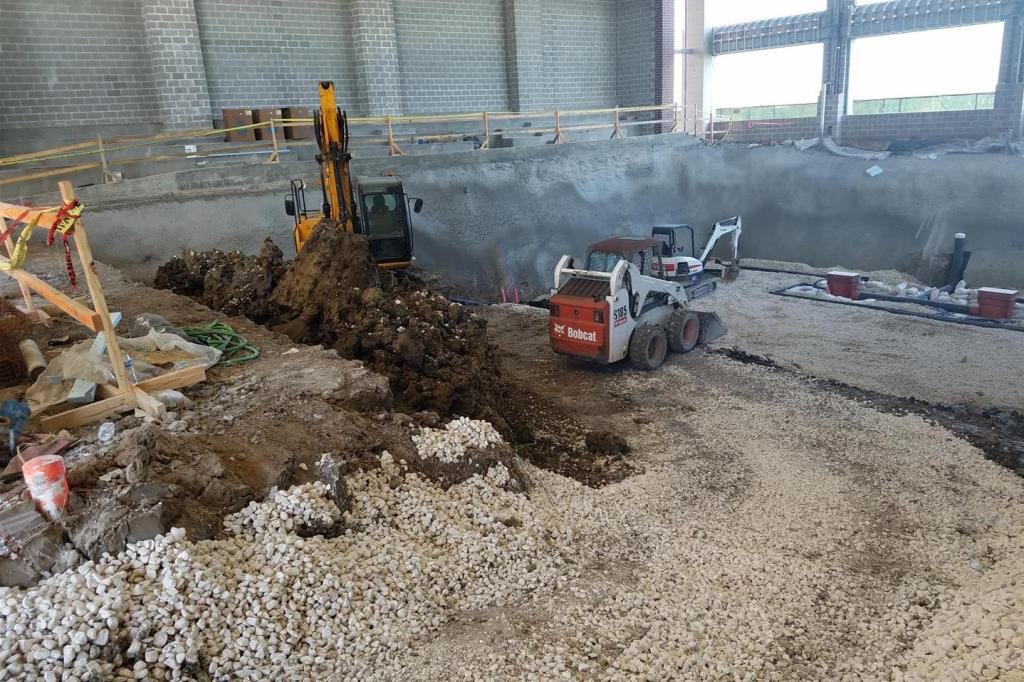One of the least conspicuous but most important design considerations for an on-grade or inground commercial pool structure involves the geotechnical, or soil, conditions.
Soil can drastically influence the design, construction methods and, in some cases, maintenance protocol for the structure. Its properties can make the difference between a simple slab-on-grade design or a more elaborate structural solution requiring deep foundations, over-excavation, soil conditioning, subsurface drainage and other measures.
Here, I will provide a brief introduction into the basic geotechnical considerations influencing pool shell design.
Proper assessment
An early step in the design of any earth-supported structural system is to study the site’s soil conditions.
This must be done by a qualified geotechnical engineer, who will provide data on the soil properties and recommendations for the foundation’s structural design. The study is performed by analyzing soil samples, in the form of borings drilled on the site.
The collected data helps delineate such properties as soil gradation, density, bearing capacity, shrink and swell potential, lateral earth pressure and groundwater conditions. It is used to determine the most appropriate structural design for the pool shell.
Swell potential is one of the most critical soil properties influencing the structural design. Soil with high swell potential is known as expansive soil and can pose a great threat to the performance of an inground pool structure if not adequately addressed. Expansive soils generally are made up of absorptive clay-like materials that swell or shrink, depending on moisture content. Certain highly expansive soil types may undergo volume changes of up to 30 percent. As you can imagine, even a minimal volume change in the soil supporting an inground structure can create movement that leads to cracking, uneven heaving or settlement of the pool shell, as well as damage to piping systems.
Expansive soil fixes
Common design solutions for expansive soils include over-excavation and replacement of expansive material with suitable soil, and/or structurally supporting the pool shell with deep foundations.
When over-excavation is necessary, the geotechnical engineer will recommend the depth to which high plasticity or expansive soils must be removed, so it can be replaced with “select fill” that exhibits the necessary properties to limit swell potential and support the structural design approach. It is also very important that the fill material be properly placed and compacted.
When the solution calls for a deep foundation, such as drilled piers or friction piles, the pool often is constructed over a void space, where soil can swell without affecting the pool. These foundations support pools by distributing the load vertically or bearing on deeper, more stable soil, such as bedrock.
A slightly less common approach to mitigating the swell potential of expansive soils is moisture conditioning. The goal is to saturate the soil before construction and maintain the moisture content throughout construction and the life of the facility. This is done to reduce the chance of significant volume changes, and is only appropriate for certain soils — generally only those that do not exhibit extreme shrink/swell potential.
Additional factors
Other soil conditions influence the pool.
Soil type may determine the most appropriate construction method for the shell. For example, construction methods where the concrete is sprayed — shotcrete, gunite — are most efficient when excavators can achieve a vertical cut in the soil, so the concrete can be shot directly against earth. But when very sandy or soft soil is present, the sides of the excavation are more likely to collapse or degrade. In these situations, pool-wall construction may require other methods to support the concrete placement, such as formwork or a stainless steel panel and buttress system. This impacts costs and sequencing of the construction among trades, especially for indoor pools, which involve adjacent building foundations.
Groundwater also must be considered in designing a pool structure, regardless of the soil type. Subsurface water can occur naturally from the water table or surface water infiltration from things such as deck runoff.
If groundwater is present at excavation depth, dewatering methods will be necessary to facilitate construction. Once the pool is in place, groundwater higher than the lowest point of an inground pool structure will exert buoyant forces on the shell. If the structure has not been designed to counteract such forces, an empty pool shell may literally float out of the ground, causing significant damage or catastrophic failure. In some cases, a subsurface drainage system is needed to remove groundwater surrounding the shell. The subgrade preparation for the pool slab and, in some cases, the backfill material must be designed to allow drainage when build-up of hydrostatic pressure is a possibility.
Groundwater levels can fluctuate significantly in some regions or even certain sites. A pool owner or operator should understand how the structure has been designed to perform and whether it is safe to drain the pool. A method of observing or monitoring the groundwater level should be provided, such as a sight well or piezometer. If a permanent subsurface drainage system is installed, it must be determined to be functioning properly before the pool is drained, especially if the system involves pumps to remove water.
Hydrostatic relief valves in the pool floor serve as another fail-safe against the effects of hydrostatic pressure on an empty pool shell.
Remember, it is critical to consult a qualified geotechnical engineer for any site. Soil properties can vary dramatically in an area, so the design approach used on an adjacent site may not be appropriate for your pool. AI
